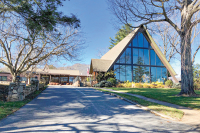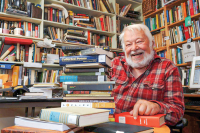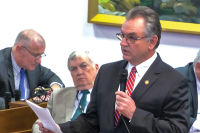Contentious vote coming on Waynesville social district

Open container alcohol consumption in cities and towns across North Carolina has met with positive results, according to local administrators and police officers — which is why opponents of Waynesville’s proposed “social district” are resorting to misinformation and sensationalism to impose their minority viewpoint on the majority of downtown stakeholders who overwhelmingly support such a district.
Social districts are a relatively new phenomenon in North Carolina, enabled by the General Assembly on Sept. 8, 2021, in HB 890 and further clarified in HB 211 in 2022.
Neither piece of legislation imposed social districts on municipalities, they merely authorize municipalities to create them if and when they so choose.
Once they do, the social districts then allow for the on-street consumption of alcohol, within clearly defined areas under controlled circumstances.
The city of Kannapolis was an early adopter, establishing the state’s first social district on Sept. 29, 2021.
“With regards to the social district, we’ve not encountered any massive uptick in crime or anything like that, or public intoxication. Most times when we have a violation or something like that, it’s just an educational opportunity and voluntary compliance,” said Terry Spry, chief of the Kannapolis Police Department who spoke to The Smoky Mountain News on June 15. “We do have quite a large amount of pedestrian and vehicular traffic with downtown development, the stadium and everything that’s going on. It just creates a large area of pedestrian opportunities but it still maintains a family-friendly environment.”
Related Items
The city of Greensboro established a social district in March, 2022.
“We have loved having the social district. It’s gone incredibly well in our downtown area. In fact, a second social district was launched about six months ago in a different part of the city. We have not seen an increase in issues or crime downtown,” Jessie Cambareri, public information officer for the Greensboro Police Department, said on June 16. “We have seen a lot of families, young couples, young adults utilize the social district and we’ve not had issues. In fact, we really do enjoy having our downtown officers engage and interact with the folks that are walking around and enjoying the social district.”
In the western region of the state, the town of Sylva moved to establish a social district in April, 2022. Less than six months later, Sylva expanded the district’s hours and days. Around that time, Sylva Police Chief Chris Hatton told The Smoky Mountain News that there had been no increase in crime due to the social district. When reached for comment on June 14 of this year, Hatton said that’s still the case.
“I don’t think we’ve even had a call,” he said.
The Town of Waynesville has been looking at establishing its own social district since early 2022, all the while eyeing Sylva’s success.
Waynesville’s effort proceeded slowly until late May of this year, when the Downtown Waynesville Commission voted unanimously to recommend to members of Town Council the establishment of a social district.
The recommendation, however, didn’t just materialize out of thin air.
Beth Gilmore, director of the DWC, said the group held two community meetings about the proposed district, and then completed a survey of 100 stakeholders. The results of the survey were clear; business owners, downtown property owners, employees and residents all want a year-round social district.
A February article in Business North Carolina magazine touts measurable increases in foot traffic and business development in cities that have established social districts, including Kannapolis, Norwood and Hickory. That same story also shoots down any suggestion that alcohol-related crime has increased in those cities.
Overall, 90% of Waynesville survey participants support the idea. Not a single downtown resident surveyed was opposed.
The DWC’s recommendation to the Town Council was shaped by the survey, and hasn’t changed since the DWC’s May 22 vote.
As proposed, the district would be in effect from 10 a.m. to 10 p.m. each day. No private property is included in the proposed district — it merely pertains to streets and sidewalks and would include Main Street from Pigeon Street to Walnut Street, including Church, Miller and Depot streets up to Montgomery Street, which is not included in the district.
The proposed district would also include Wall Street, from East Street to Wells Events Way.
Business owners are not required to participate in the district, and can prohibit alcoholic beverages on their premises in much the same way they already do for any outside food or drink. Business owners would be free to change their admission policies at will, at any time, even on a case-by-case basis.
Not long after the Downtown Waynesville Commission made its May 24 recommendation to the Waynesville Town Council, a petition was started on change.org by “Concerned Citizens.” The photo on the petition is sensational — a woman, passed out on the curb, clutching a glass bottle while another person sits on the curb next to her, surrounded by empty glass bottles near various unidentified spills on the street.
Drinking alcohol from glass bottles on the street is not a permissible activity in any social district.
On June 13, the Town of Waynesville held a vote to call for a public hearing on the DWC’s recommendation. At that time, the petition had about 100 signatures. That number had grown to about 140 by June 16.
Council Member Anthony Sutton, a Democrat, made the motion to call for the public hearing, saying that he agreed with votes on the social district legislation cast by Waynesville’s current and former representatives in the General Assembly — Kevin Corbin, Mike Clampitt and Mark Pless, who are all Republicans.
Chuck Dickson seconded Sutton’s motion because he felt the Town Council should entertain the request from the DWC, which is a town-controlled commission.
Mayor Gary Caldwell opposed the public hearing, which will be held on Tuesday, June 27. Caldwell cited his Christian faith as the reason.
Caldwell also read from a letter written by Haywood County Sheriff Bill Wilke, even though the town of Waynesville’s police department would be the lead agency on any social district within town limits. Wilke’s letter opposed the social district and directly contradicts the real-world results from other cities and towns that have established social districts.
“Should this initiative be approved, you should expect an increase in criminal offenses, as those looking to commit crimes tend to seek the easiest of victims,” Wilke wrote.
Wilke also cited his familiarity with Asheville’s open container festivals of days past, although nothing remotely approaching their scale takes place in Waynesville.
“Much like the experiences of Asheville during the festival days of Bele Chere and other regular events that permitted public consumption, the additional burden on public safety resources was immense and had to be significantly increased accordingly,” he wrote.
Perhaps the most accurate part of Wilke’s letter was about jail capacity. If — and that’s a big ‘if,’ according to law enforcement officials in other towns — arrests related to the social district in Waynesville are made, they could create capacity issues in Wilke’s detention center.
“… our sheriff’s office will need to contend with increased pressure on detention facility resources resulting from arrests,” he wrote. “With a jail that is almost always at operational capacity, and the additional expense to transport detainees elsewhere when at capacity, an additional burden on already stretched resources should be expected.”
Wilke also noted the implications of a social district on individuals struggling with substance use disorder, but such individuals aren’t required to attend events in the social district or partake in alcohol if they do.
Once Sutton’s motion passed, 10 people spoke during the public comment session of the meeting — all of them opposed to the social district, and none of them residents of the social district.
Navy veteran Joe Lipari said that when he was in the Navy, “every port that I went into was typically somewhere between a mile and two miles of bars and hookers” and that “most of the sailors turned out to be ugly Americans, including myself.” He added that he didn’t want to see Waynesville turn into a Navy port.
Lois Hollis, a nurse, said the police department already has its hands full; however, evidence from other towns with social districts suggests their hands won’t be any more full if Waynesville enacts one.
Sharon Walls cited statistics showing that 5000 young people under the age of 21 die as a result of underage drinking.
Sherry Morgan, who frequently harangues Town Council about “socialism” and supposed low-barrier homeless shelters said that “most people don't want public drinking on the streets of Waynesville,” despite the 90% level of support expressed in the survey.
“it's unnecessary and has no positive outcome,” Morgan said. “It will hurt our tourism.”
Other towns with social districts have reported only positive outcomes and increased tourism.
Melinda Davis said she’d lost her sister to alcoholism. Davis isn’t a resident of Waynesville.
Neither is Rev. Roy Kilby, of Buncombe County. Kilby frequently stands in opposition to alcohol-related issues.
Paula Eachus imagines people vomiting and urinating all over the social district, and wants to know who would clean it up. Her husband David Eachus, a vice chair of the NC-11 GOP, shared his expertise on prostitutes and pickpockets in New Orleans and Nashville.
“It all ends up being a bunch of bars, and they say watch out for the pickpockets, watch out for hookers, [watch out] from slipping into [bodily fluids],” he said. “It just becomes a disaster.”
The next meeting of Waynesville’s Town Council will take place at 6 p.m. on Tuesday, June 27 at Waynesville’s Town Hall, 9 South Main Street.









